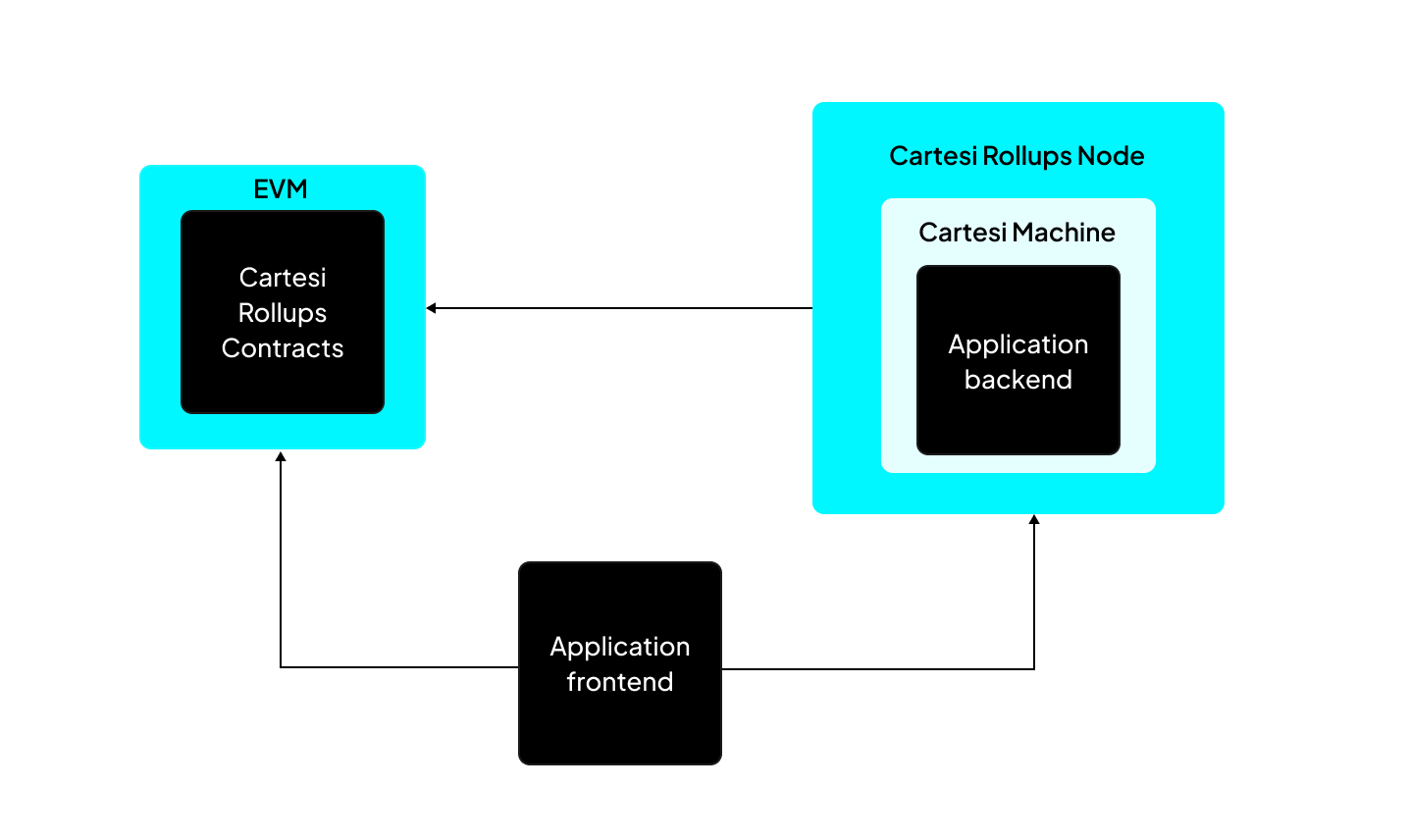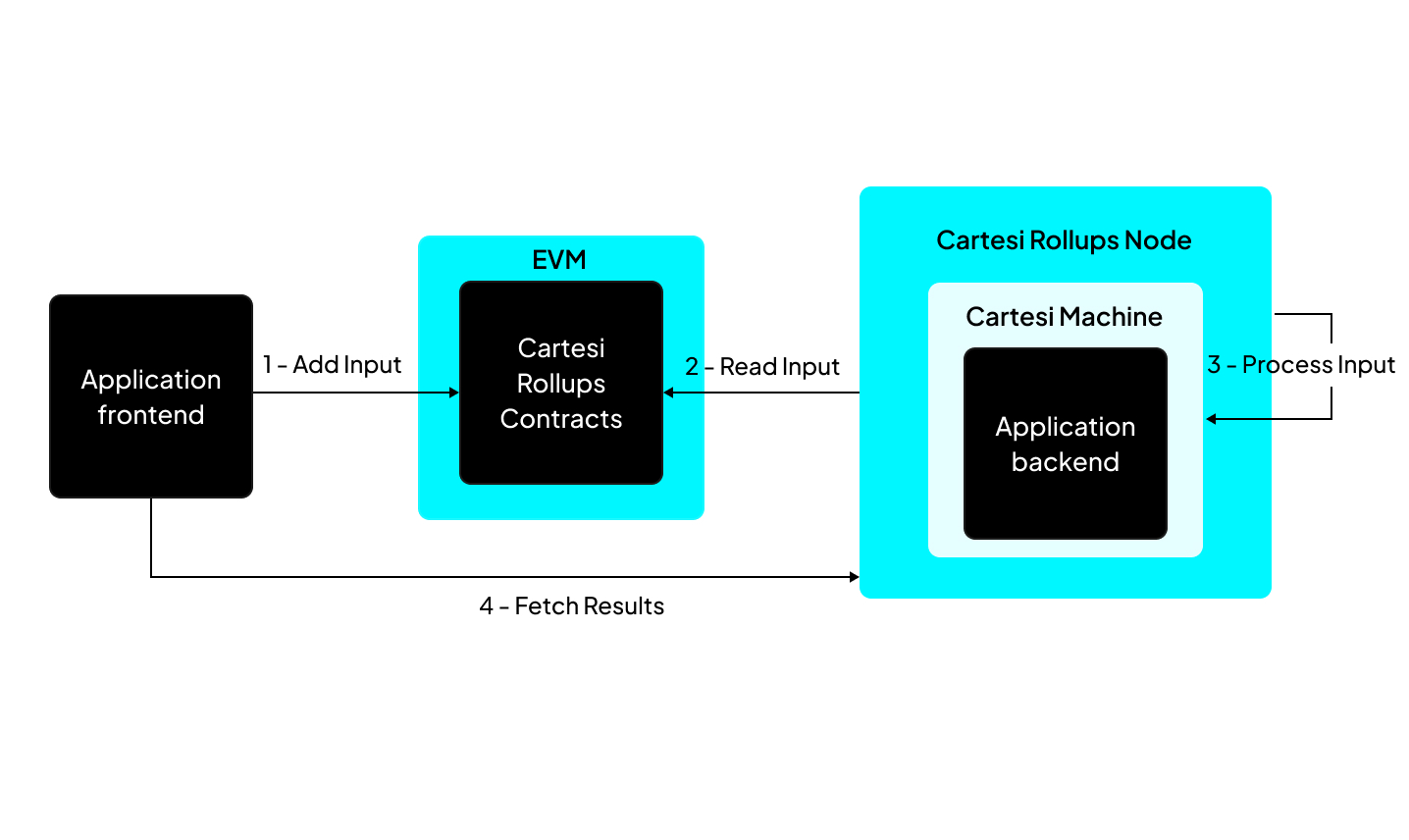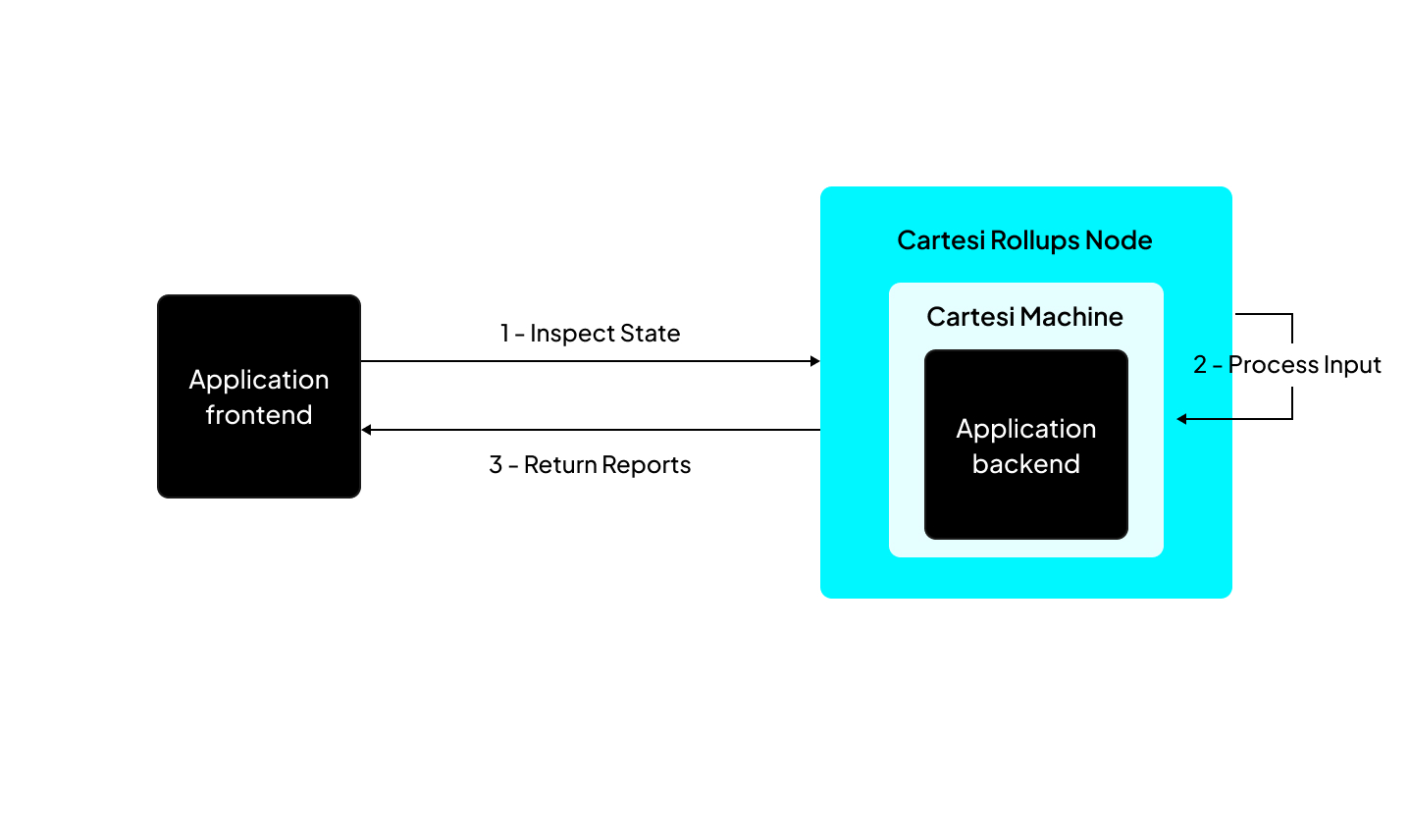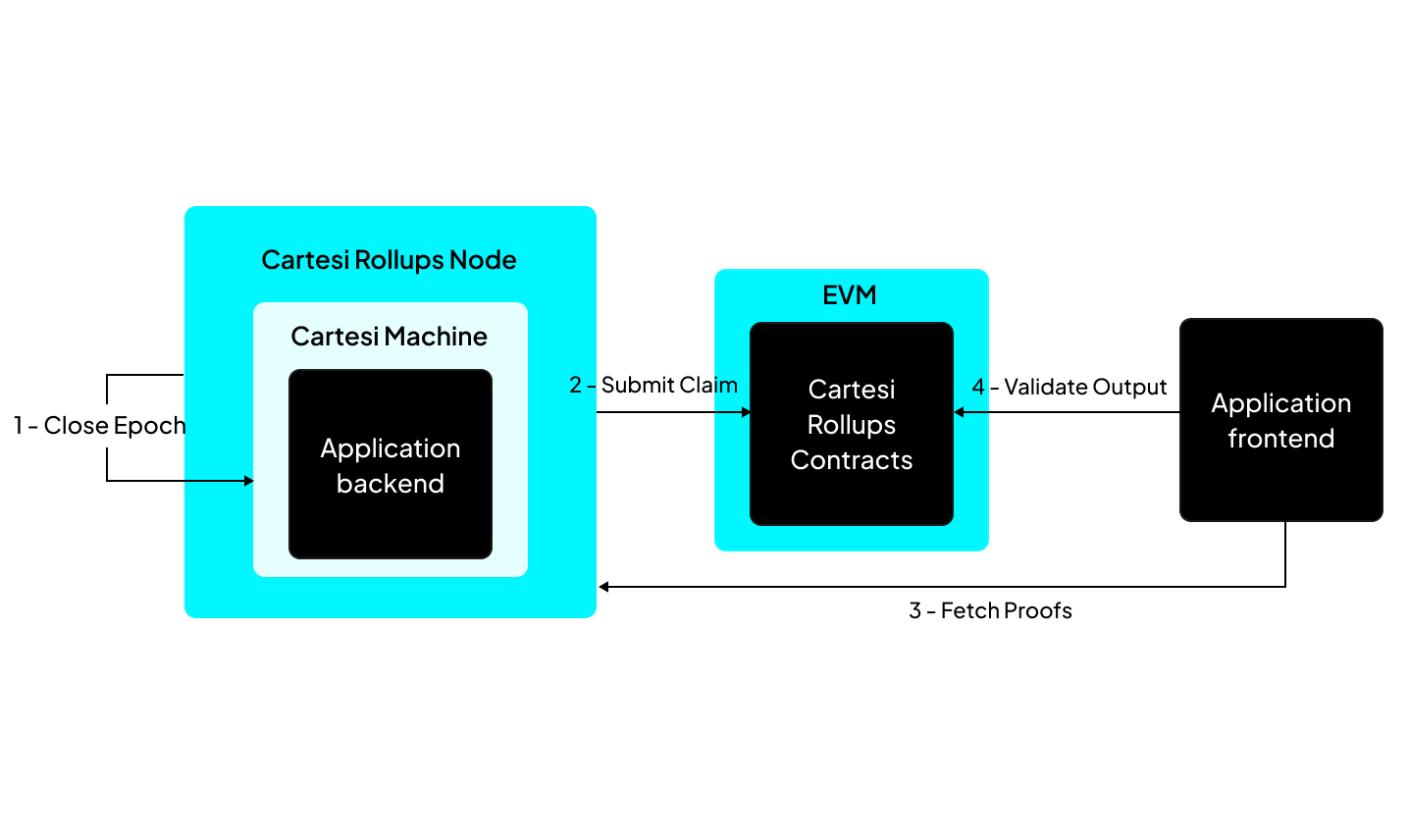Architecture
The Cartesi Rollups framework is designed to enable complex computations off-chain while maintaining the security guarantees of blockchain technology. It consists of two primary components: the on-chain base layer (such as Ethereum), where the dApp contract is deployed, and the off-chain execution layer, where the dApp's backend logic operates.
A decentralized application (dApp) built on Cartesi incorporates several key elements:
-
Cartesi Rollups: A set of on-chain(rollups contracts) and off-chain(rollups node) components that implement an Optimistic Rollup solution, providing the general framework for building dApps.
-
Cartesi Machine: A virtual machine (VM) that runs a complete Linux operating system, serving as the environment for executing the dApp's backend.
-
Backend: The application's state and verifiable logic run inside the Cartesi Machine as a standard Linux application.
-
Frontend: The application’s user-facing interface, typically implemented as a web application or a command-line interface tool.

Cartesi Machine
The Cartesi Machine forms the core of Cartesi's off-chain computation capabilities. It is a virtual machine based on the RISC-V instruction set architecture (ISA), designed to provide a deterministic and isolated execution environment.
Key features of the Cartesi Machine include:
-
Full Linux OS support: This allows developers to use familiar tools and libraries for backend development. You have flexibility in the choice of programming languages and all open-source libraries available on Linux.
-
Isolation and reproducibility: The machine operates independently, ensuring consistent behavior across executions.
-
Scalability: By leveraging significant off-chain computing power, the Cartesi Machine enables complex computations while maintaining blockchain-level security.
-
The Cartesi machine is self-contained and can't make an external request. It runs in isolation from any external influence on the computation to achieve reproducibility.
The Cartesi Machine achieves its unique balance of scalability and security by performing computations off-chain but providing mechanisms to verify these computations on-chain when necessary.
On-chain components
The on-chain part of Cartesi Rollups consists of several smart contracts deployed on the base layer.
Here is an overview of the major contracts, with each serving a specific role in the dApp ecosystem:
InputBox
The InputBox contract is the entry point for user interactions with the off-chain layer. All inputs destined for a Cartesi dApp are first submitted to this contract, which then emits events that the off-chain components can process.
CartesiDApp
Each Cartesi dApp is associated with a unique instance of the CartesiDApp contract. This contract acts as the on-chain representation of the dApp and can hold ownership of digital assets on the base layer, including Ether, ERC-20 tokens, and NFTs.
CartesiDAppFactory
The CartesiDAppFactory contract simplifies the deployment process for CartesiDApp contracts. It allows developers to deploy new CartesiDApp instances with a single function call, enhancing convenience and security. This factory approach ensures the deployed contract bytecode remains unaltered, assuring users and validators.
Portals
Portal contracts facilitate the secure transfer of assets between the base layer and the Cartesi execution environment. Currently, Cartesi supports the following types of asset transfers:
- Ether (ETH)
- ERC-20 (Fungible tokens)
- ERC-721 (Non-fungible tokens)
- ERC-1155 Single transfers
- ERC-1155 Batch transfers
These Portal contracts implement the logic to "teleport" assets safely between layers, maintaining their integrity and ownership throughout the transfer process.
Off-chain layer
The off-chain execution layer is centered around the Cartesi Rollups Node, the crucial middleware between the on-chain contracts and the Cartesi Machine. The node is responsible for:
-
Processing inputs: It reads inputs from the base layer and forwards them to the Cartesi Machine for processing.
-
State management: The node manages the state of the dApp, ensuring consistency between on-chain and off-chain representations.
-
Validation: It can act as a validator, generating claims at the end of each epoch to be submitted on-chain.
-
Inspection: The node handles requests to inspect the dApp state, facilitating queries without altering the state.
-
Output management: It operates a GraphQL server that allows clients to query the outputs produced by the dApp.
The Cartesi Rollups Node can operate in two primary modes:
1. Validator Nodes: These nodes have full responsibilities, including processing inputs, generating claims, and ensuring the validity of on-chain state updates. They can operate in secure, isolated environments as they don't need to expose endpoints for external state queries.
2. Reader Nodes (In Development): These nodes focus on advancing the off-chain state and making it publicly available. They consume information from the blockchain but do not participate in the validation process.
All Cartesi Nodes function as Validator Nodes, with Reader Node functionality under active development.
Data Flow and Processes
The Cartesi architecture facilitates several key processes that enable the functioning of dApps. These processes include:
Advance state

The advance-state process changes the application state, and it involves the following steps:
-
The application frontend submits an advance-state input to the
InputBoxsmart contract on the base layer. -
The node monitors events from the
InputBoxcontract and retrieves the input data. -
The node sends the input to the application backend inside the Cartesi Machine.
-
The Cartesi Machine processes the input and generates verifiable outputs (vouchers, notices, and reports).
-
The application frontend can query these outputs using the node's GraphQL API.
Inspect state

The inspect-state process allows for querying the application backend without altering its state:
-
The application frontend sends an inspect-state input directly to the Cartesi Node.
-
The node forwards this input to the Cartesi Machine.
-
The Cartesi Machine processes the input and generates a report.
-
The node returns this report to the frontend via a REST API.
It's important to note that inspect-state inputs do not produce vouchers or notices, and the current implementation processes inputs sequentially, which may impact scalability for applications heavily reliant on inspect-state functionality.
Validation

The validation process ensures the integrity of the off-chain computations:
-
The Cartesi Node bundles multiple
advance-stateinputs into an epoch. -
At the end of an epoch, the node computes a claim summarizing the epoch's state changes.
-
The node submits this claim to the Cartesi Rollups smart contracts on the base layer.
-
The application frontend can fetch proofs for specific outputs within a closed epoch.
-
These proofs can validate outputs on-chain, such as validating notices or executing vouchers.
Introducing Dave — an interactive fraud-proof system
Dave is Cartesi's dispute resolution algorithm designed to address shortcomings in existing fraud-proof protocols. Traditional fraud-proof systems often face challenges such as delay attacks and vulnerability to Sybil attacks, where malicious nodes can disrupt operations by continuously challenging transactions or overwhelming honest validators.
Dave introduces an approach where the resources required to defend against disputes grow logarithmically with the number of opponents. This means that defending against challenges remains affordable for a single honest node, even in the face of multiple attackers.
With Dave, a single honest participant can effectively defend their claims on-chain, ensuring the integrity of transactions without relying on trust in validators. Based on the Permissionless Refereed Tournaments algorithm, this protocol empowers anyone to validate rollups and uphold correct states on-chain, enhancing transaction security and reliability.
Similar to how a consensus algorithm is crucial for achieving agreement on a single state of the blockchain among all nodes in a base-layer chain, Dave plays a fundamental role in ensuring the integrity and trustworthiness of state transitions within Cartesi Rollups.